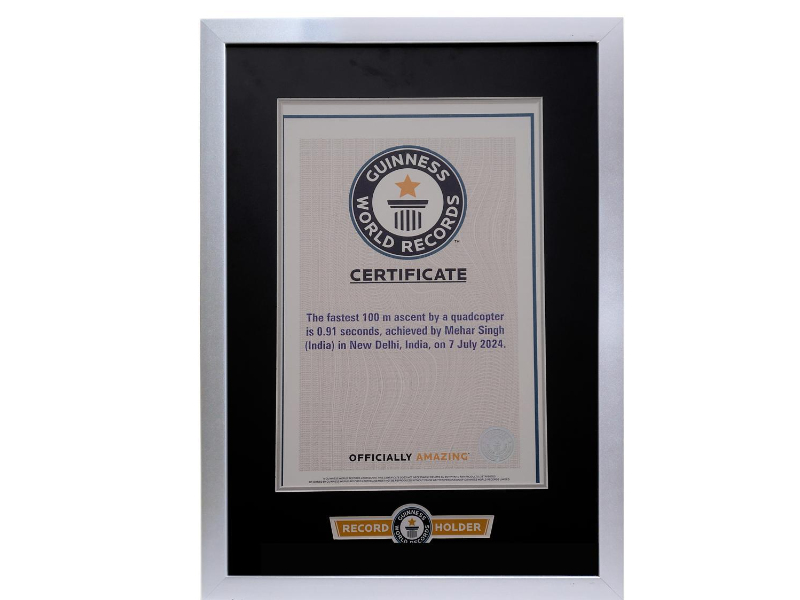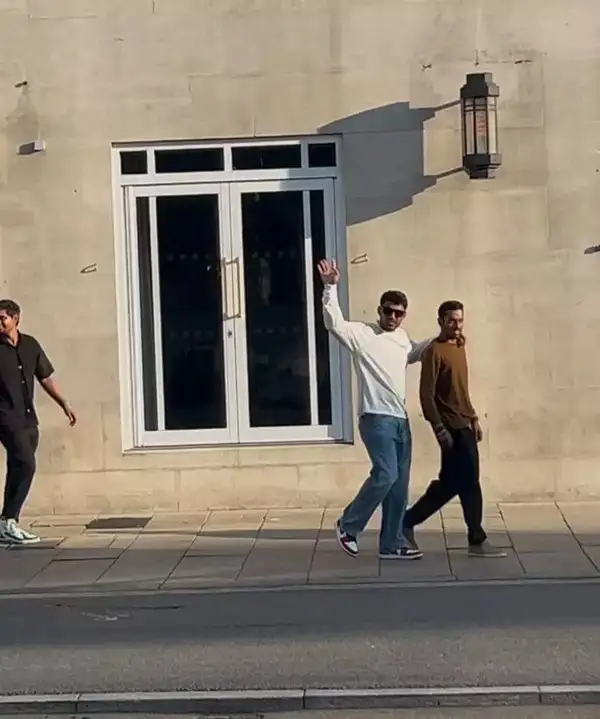At the young age of 17, Mehar Singh has catapulted himself into the global spotlight, achieving a remarkable feat by breaking the Guinness World Record for the fastest 100-meter ascent by a quadcopter. Singh's custom-built drone accomplished this milestone in a breathtaking 0.91 seconds. This achievement not only underscores his exceptional technical capabilities but also establishes a new benchmark in the dynamic field of drone technology.

Singh's path to this incredible accomplishment has been marked by passion and perseverance. His fascination with drones ignited in the 8th grade, and has continued to grow ever since. Driven by a desire to push technological boundaries, Singh embarked on a months-long project to construct a drone capable of unprecedented vertical acceleration.
"I've always been captivated by the idea of maximizing the potential of drones," Singh stated. "But achieving a world record was more than just a result; it was about the entire journey. I wanted to demonstrate that existing technology could achieve something truly remarkable, but the journey was fraught with obstacles."
The project required Singh to design, test, and refine numerous drone prototypes. "There were times when I questioned whether my dream was even attainable," Singh recalled. "I went through countless iterations, many of which failed during testing. Some drones suffered catastrophic damage, forcing me to return to the drawing board and begin again. Each crash was a setback, but it also sparked new ideas and innovations."
Undaunted by the challenges, Singh dedicated his efforts to creating a drone that was not only fast but also aerodynamically optimized. "I invested numerous hours using CAD software, meticulously designing and fine-tuning each component. The goal was to streamline the drone as much as possible, which led me to adopt a rocket-like shape. This design wasn't just for aesthetics; it was about minimizing drag and maximizing speed."
Singh’s commitment to his vision ultimately led to success. "Each failure taught me valuable lessons," he said. "It pushed me to think creatively and pay attention to every detail, from the materials used to the drone's weight distribution. The process was demanding, but seeing my ideas take flight was incredibly rewarding.”

This record-breaking achievement represents more than just personal success for Singh; it holds considerable implications for the future of drone technology. "The possibilities are limitless," Singh pondered. "High-speed vertical acceleration has the potential to revolutionize various fields, from emergency response to space exploration. This is not just about setting a record; it's about unlocking new innovations and applications."
Singh's groundbreaking work is already serving as an inspiration to others in the drone community and beyond. "I hope this achievement inspires other young innovators to push their own limits," he said. "Technology is rapidly evolving, and there's immense untapped potential. I'm excited to see what the future holds."

As Singh looks to the future, the possibilities are endless. With his record-breaking drone, he has not only etched his name in history but also paved the way for future advancements in drone technology. For this young innovator, this is just the beginning of an exciting journey into the future of flight.
Newer articles
Older articles
 Team India Settles in Birmingham: Rahul's Mattress, Coaches' Strolls, and the Enduring Coffee Ritual
Team India Settles in Birmingham: Rahul's Mattress, Coaches' Strolls, and the Enduring Coffee Ritual
 Android Users Urged to Patch Devices Immediately Following Critical Security Flaws Alert
Android Users Urged to Patch Devices Immediately Following Critical Security Flaws Alert
 Ashada Gupt Navratri 2025: Dates, Auspicious Timings, and Esoteric Significance Explained
Ashada Gupt Navratri 2025: Dates, Auspicious Timings, and Esoteric Significance Explained
 JPG to PDF: A Graphic Designer's Guide to Conversion & Best Practices
JPG to PDF: A Graphic Designer's Guide to Conversion & Best Practices
 Skin Cancer Alert: How to Identify Suspicious Moles and Early Warning Signs
Skin Cancer Alert: How to Identify Suspicious Moles and Early Warning Signs
 IRCTC's AskDisha 2.0: AI Chatbot Streamlines Train Ticket Booking, Refunds, and Travel Information
IRCTC's AskDisha 2.0: AI Chatbot Streamlines Train Ticket Booking, Refunds, and Travel Information
 The stat that could swing every NBA team's 2025-26 season
The stat that could swing every NBA team's 2025-26 season
 Bollywood's Mythological Muse: How Indian Epics Inspire Cinematic Storytelling
Bollywood's Mythological Muse: How Indian Epics Inspire Cinematic Storytelling
 Bollywood Flashback: Jackie Shroff Accused of Untoward Advance on Young Tabu at Danny Denzongpa's Party
Bollywood Flashback: Jackie Shroff Accused of Untoward Advance on Young Tabu at Danny Denzongpa's Party
 Popular Finance YouTuber's Account Hacked: Bitcoin Scam Alert and Security Tips
Popular Finance YouTuber's Account Hacked: Bitcoin Scam Alert and Security Tips